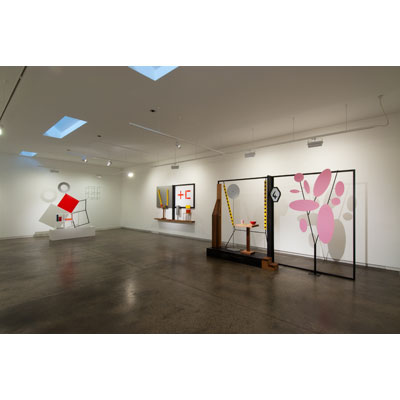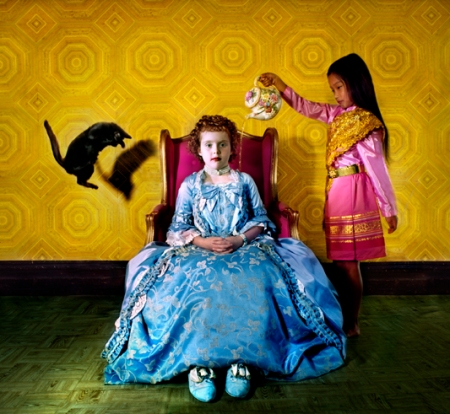
Peter D. Cole & Katherine Hattam @ John Buckley Gallery
John Buckley represents artists of great diversity, from relatively unknown newcomers, who were profiled in his last exhibition, to more established artists, such as Peter D. Cole and Katherine Hattam, whose exhibitions are on view at the gallery until April 4.
Peter D. Cole is known for his varicoloured sculptural constructions of metal and wood, and this exhibition is representative of the artist’s oeuvre. The large-scale Street – Shibuya (2009, still, wood & mixed media) and Bar 4 – Shibuya (2009, still, wood & mixed media) are visibly influenced by the artist’s trip to Japan and refer perhaps to his favourite haunts. Cole’s sparse signature style marries well with the concept of Japanese minimalism. His signature use of coloured elliptical shapes lends itself to the evocation of blossoming cherry trees, while the sparse geometry of tree trunks and branches is reminiscent of Japanese sum-e line drawing. The Information (2009, brass, wood, aluminium) on the other hand is a classic Cole sculpture, and features brightly coloured shapes and flattened three-dimensional objects. Despite its obvious references to a library or an office, it continues the artist’s engagement with the non-objective geometric abstraction. The Elemental Landscape (2009, enamel on brass) represents a fragmented deconstruction of the larger sculptures; on another level it can also be seen as a coda of Cole’s oeuvre. These miniature sculptures are simplistic and minimalist in their conception and construction, yet they are instantly recognisable as signature Cole pieces through their distinct shapes, colours, and the careful balancing of the fragments. Though the artist is not breaking new grounds or showing major departures from his aesthetic and artistic direction, the exhibition on the whole is quite enjoyable. Its mood is celebratory, the colours are bright and cheerful, and the complex shapes and ingenious constructions defy the physical weight of his large-scale structures.
Katherine Hattam’s exhibition, on the other hand, is not the best effort of this artist, who had previously shown much stronger works. The premise of the exhibition is reasonably simple: classic Penguin book covers from the 1960s and 1970s are glued to a plywood board; the board is then painted over, but certain geometric areas are left uncovered, revealing the untreated plywood and book covers underneath. Though the exhibition is perhaps homage to the art of book printing and, more generally, to the aesthetics of the 1960s and 1970s, one would expect to see such experimentation from a student artist, rather than a mature and experienced professional like Hattam.
 Derek O’Connor @ Karen Woodbury Gallery
Derek O’Connor @ Karen Woodbury Gallery
Although it is difficult to find anything new to say in the post-modern plurality of abstract painting, Derek O’Connor’s exhibition pleases greatly. He applies multiple layers of thick varicoloured paint, which is then mixed and manipulated across the picture plane (see illustration: Irregular, 2008, oil on Victorian Ash). The result is an exciting mixture of colours on the glistening and colourful surface. O’Connor knows his medium very well, and in most instances avoids muddying the colours. The painterly layers and thick swirls of paint create a visual depth, which at times is reminiscent of surreal landscapes evocative of gorges, mountain streams, glacier caves, and volcanic lava flows.
Group Show @ Sophie Gannon Gallery
The Sophie Gannon Gallery continues a mixed exhibition of gallery artists and stockroom works. The display has been changed around, and currently features works by Judith Wright, Martin Smith, Gwyn Hanssen Pigott, and others. A selection of paintings and sculpture by Vera Moller is perhaps among the most exciting works on view. She continues her exploration of what appears to be extra-terrestrial (or genetically engineered) plant-based life forms with the unnerving realism and attention to detail. The artist has not changed her subject matter for some time now, but it does not detract from the continuous exploration of her chosen subject matter and the consistently meticulous execution of her works. The exhibition also contains a woodblock by Cressida Campbell. The artist, who is predominantly known for her brightly-coloured still lives of fruits, vases, and flowers, creates woodblocks from which a unique print is made. The woodblock itself is then also offered for sale. Though such figurative style of still life genre is not to everyone’s taste, one has to admire the artist’s dexterity with the wood carving and paint application. John Nicholson is represented in this exhibition with works, which are perhaps not his most innovative pieces, but rather quite decorative and – hence – very saleable. Same can be said of Michael Zavros. He is represented in this exhibition with mimetic depictions of gems and sunglasses, which are indicative of his preoccupation with popular culture, commercial advertising, and consumerism. These works attest to his high reputation as a master of photorealism, but one is left to wonder what is next for this undoubtedly gifted artist.
Michael Staniak @ Shifted
Galleries like Shifted catch the zeitgeist almost effortlessly. They are run by and exhibit the younger generation, who work, exist, and respond to the prevalent influences within their immediate environment. It stems at the present from the popular culture, mass media, American and Japanese cartoons and comic books, science fiction, video games, and the infinite possibilities opened up by the alternative reality of the internet and its international community. These are the prevalent themes exhibited by the younger artists of such galleries as Neon Parc, Uplands, and Barry Keldoulis to name but a few. Michael Staniak is an indelible part of this community, and his exhibition Electrocircus (together with Dean Thompson) illustrates the point (see illustration: detail of Pantheon Diver, 2009, oil on board). His small scale paintings are composed of three elements: the protagonist (usually a diver or an astronaut), the antagonist (a squid- or an octopus-like creature), and the setting (whether a cosmic vacuum, biodome, or an architectural interior). Yet when Staniak mixes them together, he produces a sensation of reality which stretches beyond being merely surreal. It is virtual, and it is alternate. His divers and astronauts float around creatures which are morphed from giant squids or octopi and satellite dishes or transmitters under the cupola of the Pantheon or outside a biodome (eerily reminiscent of the Federation Square’s glass webbing). The purpose of the interaction between the humans and the creatures is unclear – they are tending to them, attempting to control them, or fighting them. Perhaps one of the underlying themes (among many other semantic meanings contained within these paintings) is our complex relationship with the technology – our simultaneous dependence and phobia or it. The meticulous execution of these works is to be admired in such relatively young artist, and it only heightens the sense of hyper-reality of Steniak’s virtual / alternate environments. The artist continues the exploration of his subject matter in delicately crafted and constructed three-dimensional installation pieces, where the fantastic creatures are based on plant-life forms, while humans and liquefied objects float in suspended animation.
 Samantha Everton @ Dickerson Galleries
Samantha Everton @ Dickerson Galleries
Samantha Everton’s photographs tend to fall short of the mark of a great photographic artist. In her current exhibition, Vintage Dolls, the ingredients for a successful work are all on display. She has great imagination; she knows how to work the camera; and how to light her scene effectively. She has a great rapport with her models, she knows how to pose them and accessorise them to attain the ultimate desired effect and the implied narrative. However, there is a persistent want of critical self-evaluation and stricter self-editing of works included in the exhibition. Vintage Dolls continues Everton’s interest in stage-setting, period costume, and the exploration of childhood and femininity. Her girls inhabit a make-believe fairy-tale world within an old crumbling house with faded wallpaper, worn carpets, and cracked walls. Dressed in either period or contemporary garb, photographed in pairs or by themselves, they re-enact childhood dreams and fantasies – princesses, actresses, Red Riding Hoods, mothers. Few works are as successful, or work as well as Camellia (2009, pigment ink on cotton paper – see illustration) or Nocturne (2009, pigment ink on cotton paper). In Camellia, a girl in a rich blue eighteenth-century gown sits in a grand chair in the centre of the composition. She’s in a presence of an attendant on the right, who pours water from a tea-pot over her, and a black kitten executing aerial acrobatics on the left. Yet nothing disturbs her serenity: she looks directly at the viewer; her stare is questioning, knowing, unnerving. Nocturne represents a girl standing in the room next to a tree which has grown through the carpet. The equilibrium of the composition is thrown off by a sudden gust of wind which tears the foliage off the tree and tousled the girl’s hair. The photograph works well compositionally because of the balance of the figure and the tree; both are united by this very sensation of energy and movement produced by the wind. The source of wind is unknown and provides a further point of interest and a deeper layer of meaning within the work, as the wind can be both a physical phenomena and an emotional experience. Other photographs do not work as well. They suffer from Everton’s penchant for over-staging. Some images are clichéd; others are shallow and lack the depth of meaning. In a number of works the girls appear unintentionally stiff and emotionally closed off. The colouring, that works so well in Camellia, in other photographs is harsh and inharmonious. There is certainly a great future for this artist, as her subject matter is current and topical, and some of the pieces in this exhibition (as well as in previous bodies of work, such as Catharsis (c. 2006-2007) and Childhood Fears (c.2007)) show that the artist is capable of strong, sophisticated, original works. One wishes though, that the artist would apply a stronger self-criticism towards her oeuvre, and release for public consumption those works which are worthy of her talent and her growing reputation, as opposed to those which are merely included to fill the exhibition space.
(C) Eugene Barilo von Reisberg, 2009










